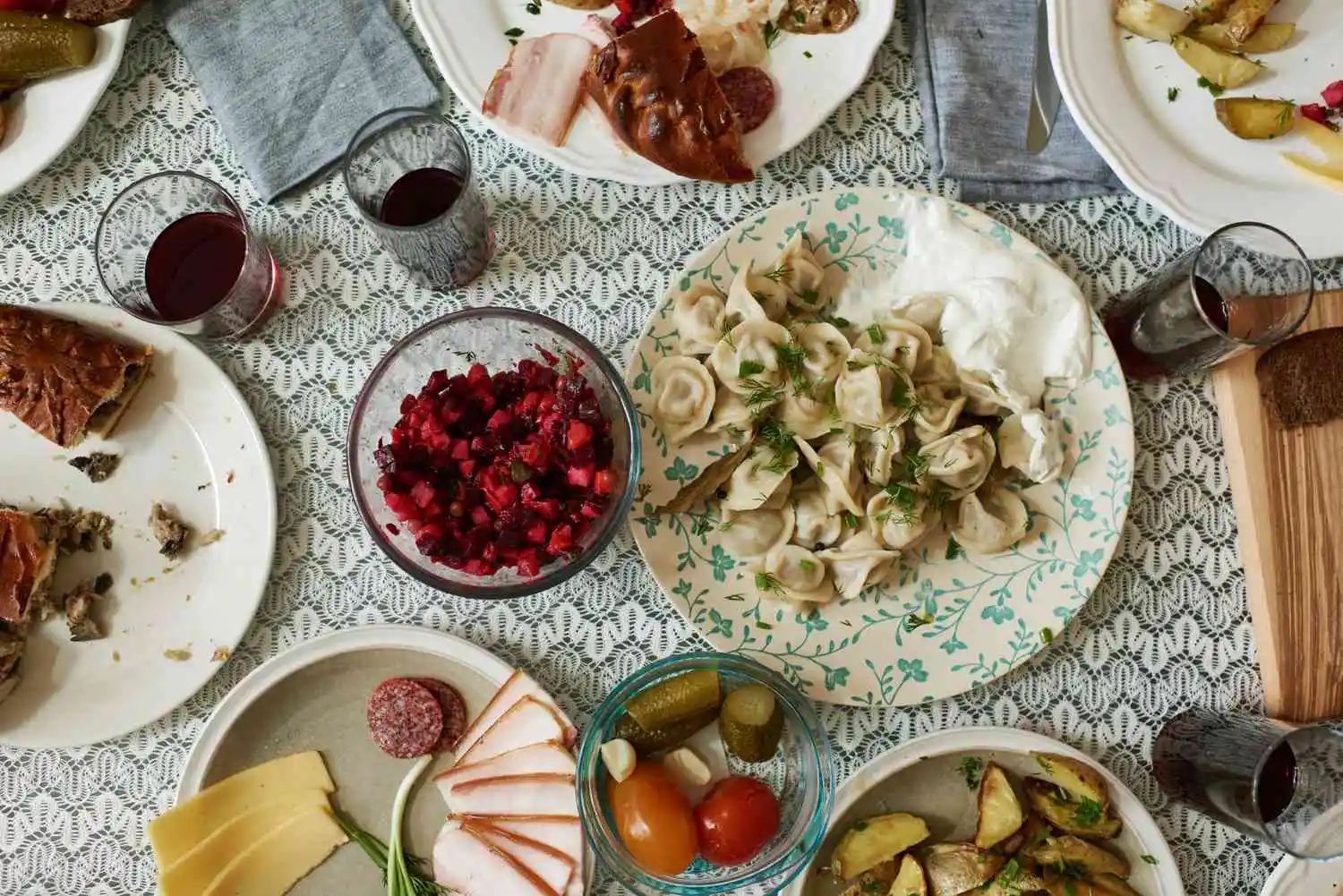Similarities Between Russian and Turkish Food
Culture/Traditions

When two rich culinary traditions meet, the result is a fascinating blend of flavors, techniques, and shared heritage. Russian and Turkish cuisines, despite their unique identities, share surprising similarities that reflect the historical and cultural connections between the regions. From hearty soups and savory pastries to the love of pickled vegetables and indulgent desserts, both cuisines celebrate comfort food made with care and tradition. In this blog, we’ll delve into the commonalities between Russian and Turkish food, uncovering how these two culinary worlds overlap in their flavors and philosophies. Get ready to embark on a delicious journey through the shared tastes of these two vibrant cultures!
Common Ingredients in Russian and Turkish Cuisine: A Flavorful Fusion
Russian and Turkish cuisines may seem distinct at first glance, but a closer look reveals a shared love for key ingredients that form the heart of their dishes. From root vegetables like potatoes, carrots, and beets to fresh herbs such as dill and parsley, both cultures rely on simple, earthy flavors. Staples like yogurt, cabbage, and legumes are also widely used, appearing in soups, salads, and side dishes. Not to mention, the shared passion for bread-making and the use of meats like lamb and beef in comforting stews or kebabs. These common ingredients reflect the resourcefulness and culinary creativity that define both cuisines, creating a flavorful fusion that bridges regional tastes.
Shared Culinary Techniques: How Russian and Turkish Dishes Are Prepared
Russian and Turkish cuisines share more than just ingredients; they also employ similar cooking techniques that highlight the essence of their flavors. Both traditions excel in slow-cooking methods, whether it’s a hearty Russian borscht or a rich Turkish güveç (casserole), allowing ingredients to meld beautifully over time. Fermentation is another common thread, used in pickling vegetables or preparing dairy products like kefir in Russia and yogurt in Turkey. Baking plays a significant role in creating beloved staples such as Russian pirozhki and Turkish börek, where doughs are filled with savory or sweet ingredients. Grilling, particularly for meats like kebabs or shashlik, is also a shared art form, bringing out smoky, charred flavors. These techniques underscore the shared appreciation for time-honored preparation methods that elevate simple ingredients into deeply satisfying dishes.
The Influence of Spices in Russian and Turkish Food Traditions
Spices play a subtle yet essential role in both Russian and Turkish cuisines, enhancing their dishes with warmth and depth. Turkish food often features bold flavors from spices like sumac, cumin, paprika, and black pepper, which bring complexity to dishes like kebabs and lentil soups. Russian cuisine, while more restrained with spices, incorporates fragrant elements like bay leaves, dill seeds, and black peppercorns, especially in soups, stews, and pickles. Both cultures share a fondness for using spices not to overpower but to harmonize with the natural flavors of fresh ingredients. This thoughtful use of seasoning reflects a deep respect for balance and tradition in both culinary traditions, creating dishes that are rich in both taste and heritage.
Bread and Pastry: The Staple Foods of Russia and Turkey
In both Russian and Turkish cuisines, bread and pastries hold a sacred place at the dining table, symbolizing hospitality, sustenance, and tradition. In Turkey, pide and simit are beloved staples, while layered pastries like börek are filled with savory or sweet ingredients. Similarly, Russia treasures its black rye bread and pirozhki, small stuffed buns perfect for a quick snack or hearty meal. Both cultures view bread not just as a side dish but as an essential part of every meal, often pairing it with soups, cheeses, or meats. Whether baked, fried, or filled, the bread and pastry traditions of these countries showcase their shared love for simple yet versatile comfort foods.
Soups and Stews: Comparing Russian and Turkish Comfort Foods
Soups and stews are central to both Russian and Turkish cuisines, offering warmth and nourishment during cold months or as a comforting everyday meal. In Russia, borscht, a hearty beet-based soup, and shchi, a cabbage soup, are staples that combine rich flavors from slow-cooked vegetables, meats, and herbs. Similarly, Turkish cuisine features comforting stews like kısır and etli nohut (chickpea stew), often made with lamb or beef, along with a variety of vegetables and spices that bring depth to each dish. Both cultures emphasize the slow-cooking technique, allowing the ingredients to meld together for a rich, flavorful result. These soups and stews are not just meals—they’re an invitation to gather around the table, sharing warmth and stories with loved ones, making them true comfort foods that transcend seasons.
Meat Dishes: Similarities in Russian and Turkish Meat-Based Recipes
Both Russian and Turkish cuisines have a deep love for meat-based dishes, with rich, savory flavors that reflect centuries of culinary tradition. In Russia, shashlik (grilled skewered meat) is a popular choice, similar to Turkey’s famous kebabs, where marinated meats such as lamb, beef, or chicken are grilled to perfection. Both cuisines use slow-cooking techniques for stews like Russia’s beef stroganoff and Turkey’s tandır (slow-cooked lamb), creating tender, flavorful dishes. Stuffed meats also make an appearance in both cultures, with Russian pirozhki and Turkish kumpir featuring stuffed meat fillings. The use of spices and marinades enhances the depth of flavor in both cuisines, highlighting their shared appreciation for hearty, flavorful meat dishes that bring people together at the table.
Dairy in Russian and Turkish Cuisine: Yogurt, Cheese, and More
Dairy plays a key role in both Russian and Turkish cuisines, with a variety of products that enrich dishes and add layers of flavor. In Turkey, yogurt is a staple, enjoyed on its own, in savory dishes like çılbır (poached eggs with yogurt), or as a refreshing side with kebabs. Similarly, Russia’s dairy offerings include smetana, a rich sour cream often served with soups and dumplings, and kefir, a fermented milk drink that’s enjoyed for its tangy flavor and health benefits. Both cultures also take pride in their cheeses—Turkey’s beyaz peynir (white cheese) and kaşar (aged cheese) are essential to breakfast spreads, while Russia features cheeses like tvorog (a soft, fresh cheese) and suluguni. Whether it’s in a drink, spread, or main dish, dairy adds both comfort and depth to the diverse flavors found in Russian and Turkish cooking.
Desserts and Sweets: A Sweet Connection Between Russian and Turkish Treats
Desserts hold a cherished place in both Russian and Turkish culinary traditions, offering a sweet connection between the two cuisines. In Russia, blini (thin pancakes) are often served with jam, honey, or sour cream, while pirozhki (sweet-filled buns) are a beloved treat. Turkish desserts, such as baklava, künefe, and lokum (Turkish delight), are renowned for their rich, syrupy sweetness and intricate textures. Both cultures use ingredients like honey, nuts, and sugar syrups to create indulgent treats that are perfect for special occasions or daily enjoyment. While the flavors and techniques may differ, the love for sweet, decadent desserts unites Russian and Turkish food traditions, making them an integral part of family gatherings, celebrations, and moments of pure pleasure.
Regional Variations in Russian and Turkish Food: Local Influences and Similarities
Both Russian and Turkish cuisines showcase a rich tapestry of regional variations, shaped by local climates, geography, and cultural influences. In Russia, the cuisine varies from the hearty, meat-based dishes of Siberia to the lighter, fish-oriented meals of the coastal regions. The Volga region is known for its rich use of fish and dairy products, while Caucasian regions like Dagestan bring bold flavors with spicy stews and skewered meats. Similarly, in Turkey, the cuisine varies dramatically across regions—southern Turkey features spicy, olive oil-rich dishes like Adana kebab, while the Aegean region boasts fresh seafood and light vegetable-based dishes. In the Black Sea region, cornmeal and fish from the sea are common. Despite these differences, both countries share similar techniques like slow-cooking, grilling, and the use of fresh, seasonal ingredients. The regional diversity of Russian and Turkish food reflects not only their cultural depth but also how local influences shape and enhance their culinary traditions.
Vegetarian Dishes: How Both Russian and Turkish Cuisines Celebrate Plant-Based Meals
Both Russian and Turkish cuisines feature a variety of delicious vegetarian dishes that celebrate the natural flavors of plants, grains, and legumes. In Russia, borscht (beet soup) and schi (cabbage soup) are often made without meat, highlighting the use of root vegetables and cabbage in hearty, satisfying ways. Vareniki, dumplings filled with potatoes, mushrooms, or cabbage, also showcase the abundance of plant-based ingredients. Similarly, Turkish cuisine offers an array of vegetarian options, such as imam bayıldı (stuffed eggplant with olive oil), mercimek köftesi (lentil patties), and zeytinyağlı dishes like green beans in olive oil. Both cuisines emphasize the use of fresh vegetables, legumes, and herbs to create flavorful, filling meals that are as satisfying as their meat-based counterparts. These plant-based dishes not only highlight the agricultural richness of both regions but also reflect a deep cultural respect for the earth’s bounty.



